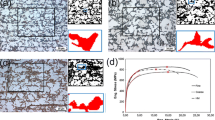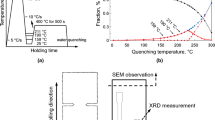Abstract
The models that have been successfully used to control the ductile-brittle transition in high strength structural steels are qualitative in nature, and address the microstructural control of the mechanisms of brittle fracture. The basic idea is incorporated in the “Yoffee diagram”, which dates from the 1920’s and attributes the ductile-brittle transition to the competition between deformation and fracture; the more difficult brittle fracture becomes, the lower the temperature at which ductile processes dominate. There are two important brittle fracture modes: intergranular separation and transgranular cleavage. The intergranular mode is usually due to chemical contamination, and is addressed by eliminating or gettering the contaminating species. There are also examples of brittle fracture that is due to inherent grain boundary weakness. In this case the failure mode is overcome by adding beneficial species (glue) to the grain boundary. Transgranular cleavage is made more difficult by refining the effective grain size. In high strength steel this is done by refining the prior austenite grain size, by interspersing islands of metastable austenite that transform martensitically under plastic strain, or by disrupting the crystallographic alignment of ferrite grains or martensite laths. The latter mechanism offers intriguing possibilities for future steels with exceptional toughness.
Similar content being viewed by others
References
S. K. Hwang and J.W. Morris Jr., Met. Trans., 11A, p. 1197 (1980)
J.I. Kim, C.K. Syn and J.W. Morris Jr., Met. Trans., 14A, p. 93 (1983)
T. Maki, in ICOMAT ’89, B.C. Muddle, ed., Trans Tech. Pub., Switzerland, p. 157 (1990)
A.J. DeArdo, in Understanding Microstructure, ASM, Metals Park, OH, p. 51 (1997)
K. Nagai, Nat. Res. Inst. Met., Tsukuba, Japan, private communication (1998)
C. Wung-Yong, POSCO, Pohang, Korea, private communication (1998)
T. Maki, K. Tsuzaki and I. Tamura, Trans. ISIJ, 20, p. 209 (1980)
H.J. Kim, Y.H. Kim and J.W. Morris Jr., 38, p. 812 (1998)
S. Jin, J. W. Morris Jr., and V. F. Zackay, Met. Trans., 6A, p. 129 (1975)
J. I. Kim and J. W. Morris Jr., Met. Trans., 12A, p. 1285 (1982)
Kobe Steel, Ltd., Technical Report No. RDPD-7902, Oct., 1979
H. J. Kim and J. W. Morris Jr., Welding J., 62, p. 210 (1983)
T. Yasuno, S. Suzuki, K. Kuribayashi and R. Horiuchi, Tetsu-to-Hagane, 83, p. 671 (1997)
K. Sato and J.W. Morris Jr., unpublished research
P.M. Novotny, in Fundamentals of Aging and Tempering in Bainitic and Martensitic Steel Products, Iron and Steel Soc., Warrendale, Pa., p. 215 (1992)
Author information
Authors and Affiliations
Rights and permissions
About this article
Cite this article
Morris, J.W. Metallurgical Control of the Ductile-Brittle Transition in High-Strength Structural Steels. MRS Online Proceedings Library 539, 23–27 (1998). https://doi.org/10.1557/PROC-539-23
Published:
Issue Date:
DOI: https://doi.org/10.1557/PROC-539-23




